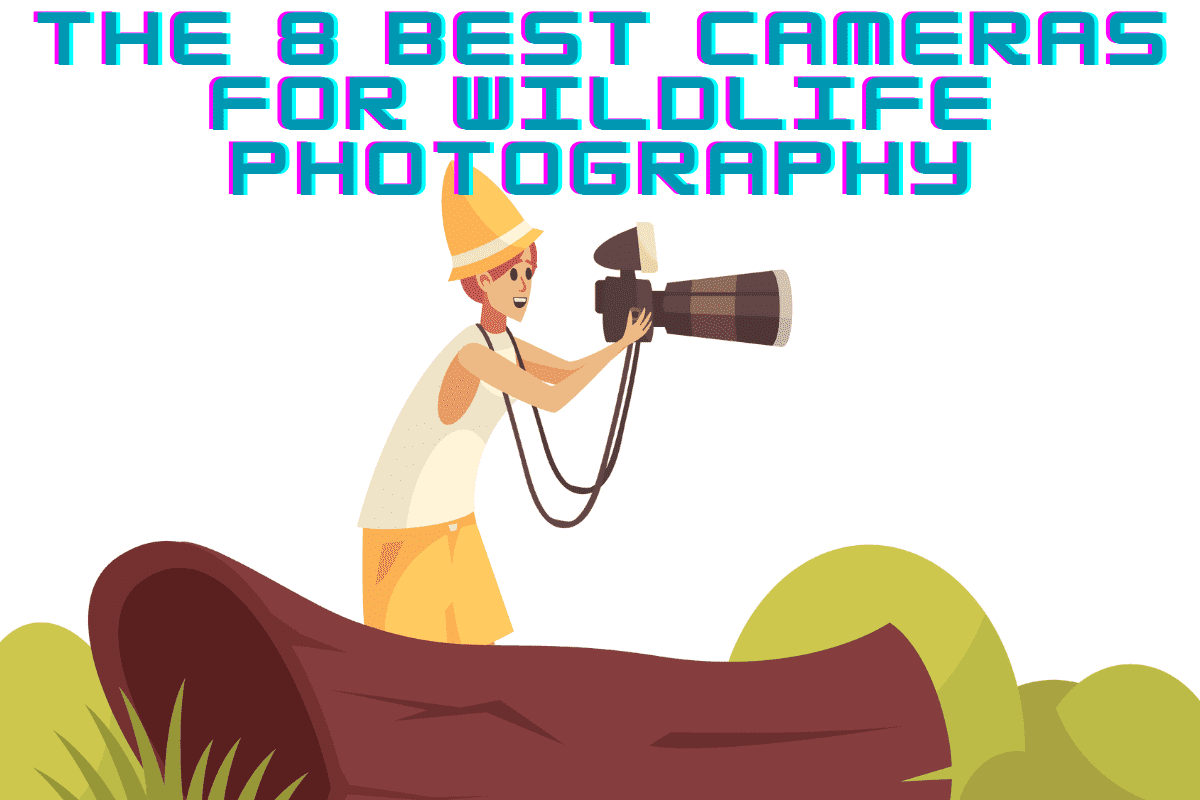
Drinks to Flush Your System
The 8 Best Drinks to Flush Your System Our bodies are constantly exposed to toxins from various sources, including the food we eat, the environment,
Discover the 8 best beginner cameras for wildlife photography that offer the perfect balance of performance, affordability price, and user-friendliness for novice photographers.
So, you’ve decided to take a walk on the wild side and venture into the thrilling world of wildlife photography? Well, you’ve come to the right place! This comprehensive guide will dive deep into the 8 best beginner cameras for wildlife photography. These best cameras strike the perfect balance of performance, affordability, and user-friendliness for budding photographers like you.
Whether you’re looking to capture an eagle’s majestic flight or a squirrel’s playful antics, the right camera can make all the difference. But with so many options out there, it can be quite the jungle! Fret not, fellow adventurer, as we’ve got you covered. So, without further ado, let’s set out on our quest to find the ideal camera for your wildlife and nature photography, needs.
The Nikon D3500 is a classic choice for beginner wildlife photographers. This entry-level DSLR boasts a 24.2-megapixel APS-C sensor, great image quality, and an easy-to-use interface. It’s the perfect tool for capturing nature’s beauty without breaking the bank.
You don’t need to be a photographer to know a great photo when you see one. And you don’t need to be a photographer to take a great photo—you just need the D3500. It’s as easy to use as a point-and-shoot, but it takes beautiful DSLR photos and videos that get noticed. It feels outstanding in your hands, sturdy, and balanced with controls where you want them. It’s compact, durable, and versatile, ideal for travel. And it works seamlessly with compatible smartphones, making it easier than ever to share your great photos. Even if you’ve never picked up a DSLR camera, you can take beautiful pictures with D3500.
24 1 Megapixel CMOS (APS-C) sensor with is 100–6400 (H: 12800)
Built-in Wi-Fi and NFC technology
9-Point AF system and AI Servo AF
Optical Viewfinder with approx 95percent viewing coverage
Use the EOS Utility Webcam Software (Mac and Windows) to turn your compatible Canon camera into a high-quality webcam
A lightweight and easy-to-use DSLR camera that makes the perfect addition for first-time users, or for those looking for an affordable upgrade. Equipped with a 24. 1 Megapixel CMOS (APS-C) sensor, DIGIC 8 image processor, and an ISO range of 100-25600 expandable
to 51200*), the EOS Rebel T8i is our most advanced EOS Rebel yet, delivering the high-quality performance that kicks your photos and videos up a notch.
Whether you’re capturing photos of friends or family, or snapping fast-moving subjects like pets or athletes,
you’ll accurately and quickly remain locked on your subject with the camera’s 45-point all cross-type AF system**, Face and Eye Detection AF and high-speed continuous shooting of up to 7 frames per second. For vloggers or social media users, the EOS Rebel T8i
offers 4K 24p video capability and vertical video support, making it easy to capture high-quality videos that can be uploaded and shared with the built-in Wi-Fi*** and Bluetooth^ technology. You’ll have a must-have tool, no matter your skill level, for bringing your photos and videos to life.
A Compact and Powerful Mirrorless Camera
Blazing-fast Autofocus and Interchangeable Lenses
20.1MP stacked back-illuminated 1″ Exmor RS CMOS sensor w/ DRAM, large aperture 24-70mm1 F1.8-2.8 ZEISS Vario-Sonnar T lens
Enhanced subject capture: wide 425 Phase/ 425 contrast detection points over 84 percent of the sensor
Fast and accurate: Up to 11Fps continuous shooting at 24.2 MP raw with crisp, clear natural colors
Multiple movie functions: Make time-lapse movies or slow/quick motion videos without post-processing
Tiltable LCD screen: customizable for vlogging, still photography, or recording a professional film
For those looking to go mirrorless, the Sony Alpha a6000 is a top contender. This compact camera boasts a 24.3-megapixel APS-C sensor, interchangeable lenses, and a lightning-fast autofocus system. It’s the perfect companion for on-the-go wildlife photography.
4K video and 4K photo:
Leica DC Vario Elmarit lens: 24x zoom
The 12.1 Megapixel high sensitivity MOS sensor
Splash Proof/dustproof rugged camera design with tight seals on every joint, dial, and button, so it stands up to harsh weather conditions and challenging
5 Axis Hybrid Optical Image Stabilizer Plus: Reduces blur from 1 handed video shooting by compensating for 5 types of movement
The Panasonic Lumix DMC FZ300K long zoom digital camera offers 4K video features and a Leica DC lens with 24x zoom and a bright F2. 8 aperture across the entire zoom range. Capture moments with superb 4K imaging performance in both video and exclusive 4K photos. The 4K photo function can be used in three different modes, all allowing you to capture that perfect moment at a high burst Rate of 30 frames/photos per second. 4K video delivers a far more intense viewing experience that is four times larger than Full HD, resulting in a much higher level of detail. Built into a splashproof/dustproof rugged camera body The Leica lens offers 5-axis hybrid optical image stabilization that assures steady photos and videos, and a high sensitivity sensor with superb low light image quality.
The Lumix FZ300 digital camera features a snug, hand-fitting grip and an intuitive level of operation. Control remotely by using the Panasonic image app on your Wi-Fi-enabled smartphone or tablet. View The image, set the focus, or release the shutter from a distance, and then transfer images for sharing on social media. The creative panorama function allows you to create Dynamic panoramic photos by simply panning the camera. Panasonic depth from defocus (DFD) autofocus (AF) technology instantly calculates the distance between foreground and bac kilogram round and quickly brings the subject into focus in one fast, continuous movement. Disclaimer: 35 mm camera equivalent: 25 600 mm. 4K photo feature extracts megapixels photo out of a 4K video sequence up to QFHD: 3840 x 2160 Pixels, 30 fps, 100Mbit/s. 4K photo feature extracts megapixels photos out of a 4K video sequence up to QFHD: 3840 x 2160 Pixels, 30 fps, 100Mbit/s. 5 Axis hybrid O. I. S. Works in video recording except for 4K video recording. Zoom Intelligent Zoom 2x, Extra Optical Zoom (EZ) 1.23x, Extra Optical Zoom (EZ) 1.95x.
Research suggests that Coenzyme Q10 (CoQ10) as a dietary supplement aids in everything from cognitive function, healthy cardiovascular system, preventing congestive heart failure, experiencing fatigue, helps improve energy levels, preventing early Parkinson disease, counteracting fatty foods, mitochondrial dysfunction, the list of benefits goes on and on.
Get to know your camera inside out
Master the art of patience
Learn about your subjects’ behavior and habitat
Practice proper camera handling and stabilization techniques
Use appropriate lenses for different situations
Experiment with various camera settings and modes
Utilize the golden hours for optimal lighting
Respect nature and wildlife
Get creative with your compositions
Join wildlife photography communities and learn from fellow enthusiasts
20 MP Live MOS Sensor
Always-on connection and background connection via Bluetooth & OI Share Smartphone app
Flip-down monitor and dedicated selfie mode. Selfie mode automatically turns on when the monitor is flipped down.
In-Body 5-Axis Image Stabilization is capable of 4.5 shutter speed steps of compensation.
16 Art Filters (31 types). Includes new Instant Film for a nostalgic feel
Digital zoom: 2.0 multiplier_x
Optical zoom: 1.0 multiplier_x
If you’re after a stylish and feature-rich camera, the Olympus OM-D E-M10 Mark IV is a fantastic option. This mirrorless camera comes with a 20-megapixel Micro Four Thirds sensor, 5-axis image stabilization, and 4K video capabilities. You’ll be capturing wildlife like a pro in no time.
The Fujifilm X-T200 is a fantastic choice for those who appreciate a retro aesthetic. This compact mirrorless camera offers a 24.2-megapixel APS-C sensor, impressive image quality, and 4K video capabilities. With its vintage charm and a range of modern features, you’ll be capturing stunning wildlife moments with style.
Make the most of your everyday moments and never miss a chance to have a memory be part of your story. FUJIFILM X-T200 puts professional-level features at the fingertips of creatives, giving them a new light-weight and compact mirrorless camera body that features a high-resolution EVF, quick and accurate face-detection AF, the power to create 24.2MP stills at 8 FPS, and even the ability to record 4K UHD video from almost any angle with its widescreen vari-angle LCD Touch Screen.
When it comes to superzoom capabilities, the Nikon Coolpix P900 is the reigning champ. This bridge camera boasts a massive 83x optical zoom, a 16-megapixel sensor, and built-in Wi-Fi for easy sharing. With this camera in hand, you’ll be able to get up close and personal with even the most elusive wildlife.
Last but not least, the Canon PowerShot SX70 HS is an excellent choice for those seeking a beginner-friendly superzoom camera. This bridge camera features a 65x optical zoom, a 20.3-megapixel sensor, and 4K video capabilities. You’ll be snapping stunning wildlife shots from afar with ease.
Embarking on the journey of wildlife photography can be a thrilling and rewarding experience. Choosing the right beginner camera for wildlife photography is essential for capturing the beauty of the natural world. With this guide, you now have a solid foundation to start exploring the top cameras available and essential features to consider.
Remember, practice makes perfect, and learning from fellow enthusiasts can help you grow as a wildlife photographer. By mastering your equipment and developing your skills, you’ll be well on your way to capturing stunning images of animals and nature’s wonders. Good luck, and happy shooting!
When selecting a beginner camera for wildlife photography, consider factors like image quality, autofocus performance, zoom capabilities, portability, and your budget. The 8 best beginner cameras for wildlife photography listed above cater to a variety of needs and preferences.
Both DSLR and mirrorless cameras are suitable for wildlife photography. While DSLRs are often more robust and offer a wider selection of lenses, mirrorless cameras are more compact and offer faster autofocus systems. It ultimately boils down to your personal preferences best camera, and needs.
For wildlife photography, you’ll want to invest in telephoto lenses with focal lengths ranging from 300mm to 600mm. These lenses allow you to capture subjects from a distance while maintaining image quality and sharpness.
A telephoto zoom lens, such as a 70-300mm or 100-400mm, is a versatile choice for beginner wildlife photographers. These lenses allow you to capture subjects from a distance, providing you with the flexibility to photograph various types of birds and wildlife without disturbing them.
The price range for a beginner camera for wildlife photography can vary widely, from around $500 to over $1,500. It’s important to consider your budget, but also prioritize the features and capabilities of expensive cameras that will best serve your needs in the field. Remember, investing in quality gear is essential, but so is honing your skills as a photographer.
While smartphones have come a long way in terms of camera capabilities, they still fall short when it comes to wildlife photography. The limited zoom capabilities and smaller sensors found in smartphones can’t match the performance of dedicated cameras, especially when shooting fast-moving subjects or in low-light situations.
A tripod can be a reliable and valuable tool for wildlife photographers, providing stability and helping to capture sharp images, particularly in low-light situations or when using telephoto lenses. However, a tripod may not always be necessary, especially when photographing fast-moving subjects or when a monopod or other stabilization techniques can suffice.
*Disclosure: I only recommend products I would use myself and all opinions expressed here are our own. This post may contain affiliate links that at no additional cost to you, I may earn a small commission.”

The 8 Best Drinks to Flush Your System Our bodies are constantly exposed to toxins from various sources, including the food we eat, the environment,

The 8 Best Beginner Cameras for Wildlife Photography: Capture Nature’s Wonders Discover the 8 best beginner cameras for wildlife photography that offer the perfect balance

The 8 Best CoQ10 Supplements What is CoQ10? Coenzyme Q10 (CoQ10) is a naturally occurring essential nutrient and antioxidant that plays a crucial role in

The 8 Best CoQ10 Gummies Boosting Your Health with a Sweet Treat Chew Your Way to Wellness: One of the primary benefits of CoQ10 gummies
Stay up to date with the most information packed articles and the best deals available.